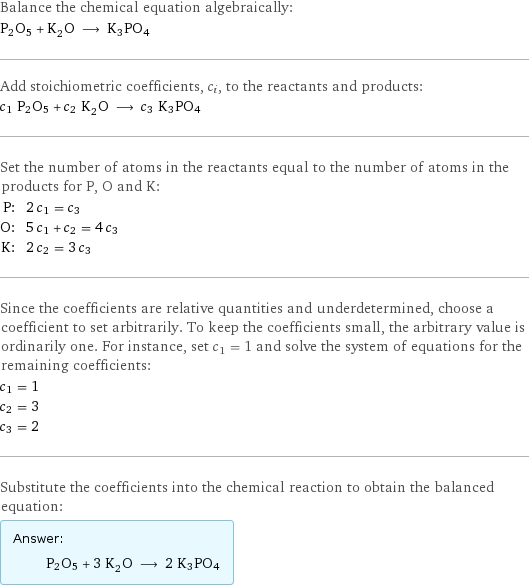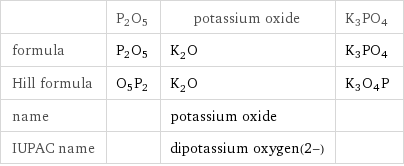Input interpretation

P2O5 + K_2O potassium oxide ⟶ K3PO4
Balanced equation

Balance the chemical equation algebraically: P2O5 + K_2O ⟶ K3PO4 Add stoichiometric coefficients, c_i, to the reactants and products: c_1 P2O5 + c_2 K_2O ⟶ c_3 K3PO4 Set the number of atoms in the reactants equal to the number of atoms in the products for P, O and K: P: | 2 c_1 = c_3 O: | 5 c_1 + c_2 = 4 c_3 K: | 2 c_2 = 3 c_3 Since the coefficients are relative quantities and underdetermined, choose a coefficient to set arbitrarily. To keep the coefficients small, the arbitrary value is ordinarily one. For instance, set c_1 = 1 and solve the system of equations for the remaining coefficients: c_1 = 1 c_2 = 3 c_3 = 2 Substitute the coefficients into the chemical reaction to obtain the balanced equation: Answer: | | P2O5 + 3 K_2O ⟶ 2 K3PO4
Structures

P2O5 + ⟶ K3PO4
Names

P2O5 + potassium oxide ⟶ K3PO4
Equilibrium constant
![Construct the equilibrium constant, K, expression for: P2O5 + K_2O ⟶ K3PO4 Plan: • Balance the chemical equation. • Determine the stoichiometric numbers. • Assemble the activity expression for each chemical species. • Use the activity expressions to build the equilibrium constant expression. Write the balanced chemical equation: P2O5 + 3 K_2O ⟶ 2 K3PO4 Assign stoichiometric numbers, ν_i, using the stoichiometric coefficients, c_i, from the balanced chemical equation in the following manner: ν_i = -c_i for reactants and ν_i = c_i for products: chemical species | c_i | ν_i P2O5 | 1 | -1 K_2O | 3 | -3 K3PO4 | 2 | 2 Assemble the activity expressions accounting for the state of matter and ν_i: chemical species | c_i | ν_i | activity expression P2O5 | 1 | -1 | ([P2O5])^(-1) K_2O | 3 | -3 | ([K2O])^(-3) K3PO4 | 2 | 2 | ([K3PO4])^2 The equilibrium constant symbol in the concentration basis is: K_c Mulitply the activity expressions to arrive at the K_c expression: Answer: | | K_c = ([P2O5])^(-1) ([K2O])^(-3) ([K3PO4])^2 = ([K3PO4])^2/([P2O5] ([K2O])^3)](../image_source/f8985c7b140c5ce2f44bfff5fa817e03.png)
Construct the equilibrium constant, K, expression for: P2O5 + K_2O ⟶ K3PO4 Plan: • Balance the chemical equation. • Determine the stoichiometric numbers. • Assemble the activity expression for each chemical species. • Use the activity expressions to build the equilibrium constant expression. Write the balanced chemical equation: P2O5 + 3 K_2O ⟶ 2 K3PO4 Assign stoichiometric numbers, ν_i, using the stoichiometric coefficients, c_i, from the balanced chemical equation in the following manner: ν_i = -c_i for reactants and ν_i = c_i for products: chemical species | c_i | ν_i P2O5 | 1 | -1 K_2O | 3 | -3 K3PO4 | 2 | 2 Assemble the activity expressions accounting for the state of matter and ν_i: chemical species | c_i | ν_i | activity expression P2O5 | 1 | -1 | ([P2O5])^(-1) K_2O | 3 | -3 | ([K2O])^(-3) K3PO4 | 2 | 2 | ([K3PO4])^2 The equilibrium constant symbol in the concentration basis is: K_c Mulitply the activity expressions to arrive at the K_c expression: Answer: | | K_c = ([P2O5])^(-1) ([K2O])^(-3) ([K3PO4])^2 = ([K3PO4])^2/([P2O5] ([K2O])^3)
Rate of reaction
![Construct the rate of reaction expression for: P2O5 + K_2O ⟶ K3PO4 Plan: • Balance the chemical equation. • Determine the stoichiometric numbers. • Assemble the rate term for each chemical species. • Write the rate of reaction expression. Write the balanced chemical equation: P2O5 + 3 K_2O ⟶ 2 K3PO4 Assign stoichiometric numbers, ν_i, using the stoichiometric coefficients, c_i, from the balanced chemical equation in the following manner: ν_i = -c_i for reactants and ν_i = c_i for products: chemical species | c_i | ν_i P2O5 | 1 | -1 K_2O | 3 | -3 K3PO4 | 2 | 2 The rate term for each chemical species, B_i, is 1/ν_i(Δ[B_i])/(Δt) where [B_i] is the amount concentration and t is time: chemical species | c_i | ν_i | rate term P2O5 | 1 | -1 | -(Δ[P2O5])/(Δt) K_2O | 3 | -3 | -1/3 (Δ[K2O])/(Δt) K3PO4 | 2 | 2 | 1/2 (Δ[K3PO4])/(Δt) (for infinitesimal rate of change, replace Δ with d) Set the rate terms equal to each other to arrive at the rate expression: Answer: | | rate = -(Δ[P2O5])/(Δt) = -1/3 (Δ[K2O])/(Δt) = 1/2 (Δ[K3PO4])/(Δt) (assuming constant volume and no accumulation of intermediates or side products)](../image_source/553002cf7f12854bfaccf840772d305a.png)
Construct the rate of reaction expression for: P2O5 + K_2O ⟶ K3PO4 Plan: • Balance the chemical equation. • Determine the stoichiometric numbers. • Assemble the rate term for each chemical species. • Write the rate of reaction expression. Write the balanced chemical equation: P2O5 + 3 K_2O ⟶ 2 K3PO4 Assign stoichiometric numbers, ν_i, using the stoichiometric coefficients, c_i, from the balanced chemical equation in the following manner: ν_i = -c_i for reactants and ν_i = c_i for products: chemical species | c_i | ν_i P2O5 | 1 | -1 K_2O | 3 | -3 K3PO4 | 2 | 2 The rate term for each chemical species, B_i, is 1/ν_i(Δ[B_i])/(Δt) where [B_i] is the amount concentration and t is time: chemical species | c_i | ν_i | rate term P2O5 | 1 | -1 | -(Δ[P2O5])/(Δt) K_2O | 3 | -3 | -1/3 (Δ[K2O])/(Δt) K3PO4 | 2 | 2 | 1/2 (Δ[K3PO4])/(Δt) (for infinitesimal rate of change, replace Δ with d) Set the rate terms equal to each other to arrive at the rate expression: Answer: | | rate = -(Δ[P2O5])/(Δt) = -1/3 (Δ[K2O])/(Δt) = 1/2 (Δ[K3PO4])/(Δt) (assuming constant volume and no accumulation of intermediates or side products)
Chemical names and formulas

| P2O5 | potassium oxide | K3PO4 formula | P2O5 | K_2O | K3PO4 Hill formula | O5P2 | K_2O | K3O4P name | | potassium oxide | IUPAC name | | dipotassium oxygen(2-) |
Substance properties

| P2O5 | potassium oxide | K3PO4 molar mass | 141.94 g/mol | 94.196 g/mol | 212.26 g/mol
Units
